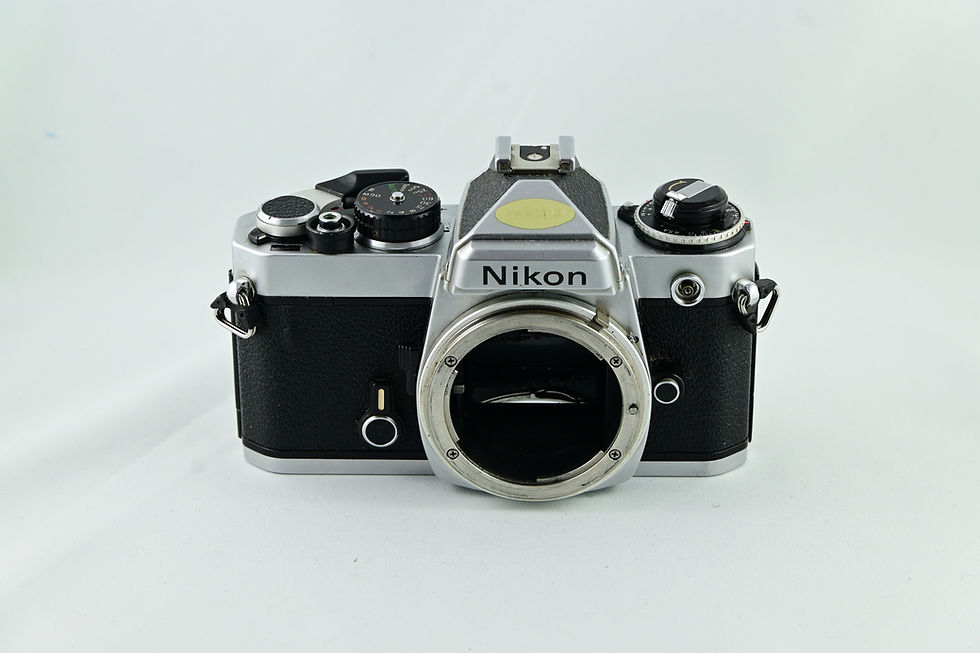Nikon FE
- hometecheasy
- Aug 25
- 3 min read
Updated: Aug 26

The Nikon FE is a classic 35mm single-lens reflex (SLR) camera introduced by Nikon Corporation in 1978. It was designed as a mid-range camera, offering advanced features like aperture-priority autoexposure and through-the-lens (TTL) metering in a compact and affordable package. The FE was part of Nikon's compact SLR series, which also included the Nikon FM and Nikon FG. Here’s a detailed look at the Nikon FE:
Historical Context
The Nikon FE was released in 1978 as a successor to the Nikon EL and was designed to appeal to enthusiast photographers who wanted advanced features without the high cost of professional models like the Nikon F2 or F3.
It was part of Nikon's strategy to compete with other popular mid-range SLRs like the Canon AE-1 and Pentax ME.
The FE was known for its simplicity, reliability, and versatility, making it a favorite among amateur and semi-professional photographers.
It remained in production until 1983, when it was replaced by the Nikon FE2.


Key Features
Aperture-Priority Autoexposure:
The FE featured aperture-priority autoexposure, allowing photographers to set the aperture while the camera automatically selected the appropriate shutter speed.
This made it easier to achieve proper exposure in fast-paced shooting situations.
Manual Exposure Control:
In addition to autoexposure, the FE offered manual exposure control, giving photographers full creative control over their settings.
TTL Metering System:
The FE used a center-weighted TTL metering system, which measured light through the lens for accurate exposures.
The meter was powered by two 1.5V silver oxide batteries (SR44 or equivalent).
Shutter:
The FE featured a vertical-travel, electronically controlled shutter with speeds ranging from 8 seconds to 1/1000 second, plus Bulb mode.
The shutter was known for its precision and quiet operation.

Viewfinder:
The FE had a fixed prism viewfinder with 93% frame coverage and a 0.86x magnification.
The viewfinder displayed shutter speed, aperture, and exposure mode information, making it highly user-friendly.
Lens Compatibility:
The FE used the Nikon F-mount, making it compatible with a wide range of Nikkor lenses, including AI (Automatic Indexing) and AI-S lenses.
Popular lenses included the 50mm f/1.8, 35mm f/2, and 105mm f/2.5.
Build Quality:
The FE was built to withstand heavy use, with a durable metal body and chrome finish.
It was designed for reliability, making it a popular choice for photographers in various conditions.
Film Advance and Rewind:
The camera featured a rapid-wind lever for quick film advance and an automatic rewind function at the end of the roll.
Accessories:
The FE was compatible with a range of accessories, including:
Motor Drive MD-11: Allowed for continuous shooting at up to 3.2 frames per second.
Speedlight SB-10: A compact external flash unit designed for use with the FE.

Notable Variants
The Nikon FE was part of Nikon's compact SLR series, which included several models:
Nikon FM (1977): A fully mechanical camera without autoexposure.
Nikon FE (1978): Introduced aperture-priority autoexposure.
Nikon FM2 (1982): A more advanced mechanical camera with a faster shutter speed.
Nikon FE2 (1983): An upgraded version of the FE with a faster shutter speed and improved features.

Why the Nikon FE is Special
Ease of Use: The FE's aperture-priority autoexposure made it easy for beginners to achieve proper exposure, while its manual controls appealed to more experienced photographers.
Reliability: Its durable construction and electronic shutter made it a dependable choice for everyday use.
Versatility: The FE's compatibility with a wide range of lenses and accessories made it highly adaptable to different shooting scenarios.
Legacy: The FE helped establish Nikon as a leader in the enthusiast camera market, paving the way for later models like the Nikon FM2 and FE2.
Collectibility and Market Value
The Nikon FE is highly collectible, particularly among fans of vintage Nikon cameras.
Prices vary depending on the condition, included accessories, and whether the camera has its original packaging.
Well-preserved models with working meters and clean optics tend to command higher prices.

Conclusion
The Nikon FE is a classic SLR camera that combines ease of use, reliability, and versatility. Its aperture-priority autoexposure and compatibility with a wide range of lenses made it a favorite among enthusiasts and semi-professional photographers during its heyday. Today, it remains a beloved camera for collectors and film photography enthusiasts, representing an important chapter in Nikon's storied history.



Comments